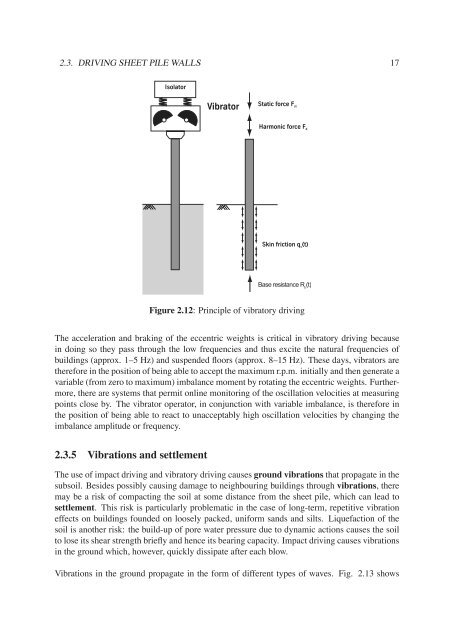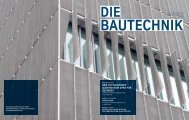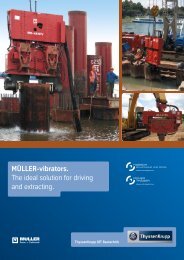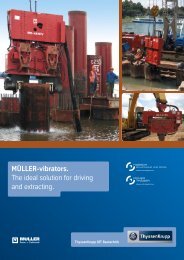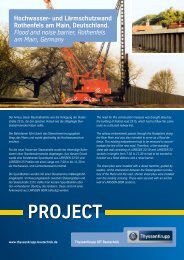pdf (3.6 MB) - ThyssenKrupp Bautechnik
pdf (3.6 MB) - ThyssenKrupp Bautechnik
pdf (3.6 MB) - ThyssenKrupp Bautechnik
You also want an ePaper? Increase the reach of your titles
YUMPU automatically turns print PDFs into web optimized ePapers that Google loves.
2.3. DRIVING SHEET PILE WALLS 17<br />
Base resistance R b (t)<br />
Figure 2.12: Principle of vibratory driving<br />
The acceleration and braking of the eccentric weights is critical in vibratory driving because<br />
in doing so they pass through the low frequencies and thus excite the natural frequencies of<br />
buildings (approx. 1–5 Hz) and suspended floors (approx. 8–15 Hz). These days, vibrators are<br />
therefore in the position of being able to accept the maximum r.p.m. initially and then generate a<br />
variable (from zero to maximum) imbalance moment by rotating the eccentric weights. Furthermore,<br />
there are systems that permit online monitoring of the oscillation velocities at measuring<br />
points close by. The vibrator operator, in conjunction with variable imbalance, is therefore in<br />
the position of being able to react to unacceptably high oscillation velocities by changing the<br />
imbalance amplitude or frequency.<br />
2.3.5 Vibrations and settlement<br />
The use of impact driving and vibratory driving causes ground vibrations that propagate in the<br />
subsoil. Besides possibly causing damage to neighbouring buildings through vibrations, there<br />
may be a risk of compacting the soil at some distance from the sheet pile, which can lead to<br />
settlement. This risk is particularly problematic in the case of long-term, repetitive vibration<br />
effects on buildings founded on loosely packed, uniform sands and silts. Liquefaction of the<br />
soil is another risk: the build-up of pore water pressure due to dynamic actions causes the soil<br />
to lose its shear strength briefly and hence its bearing capacity. Impact driving causes vibrations<br />
in the ground which, however, quickly dissipate after each blow.<br />
Vibrations in the ground propagate in the form of different types of waves. Fig. 2.13 shows


